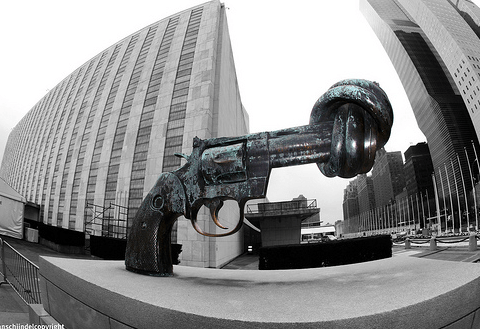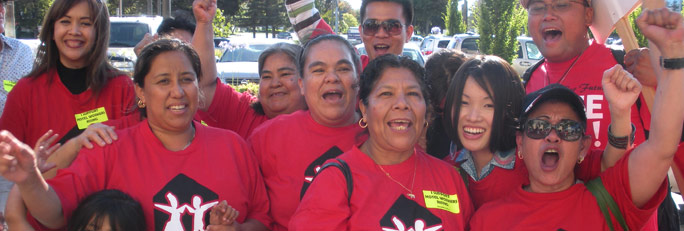(An Occasional Series.)
Why We Look Backward as We Move Forward.
Unbound is an ecumenical e-journal offering analysis, practical resources, interactive conversation, and action items for issues of justice and Christian conscience. Begun in 2011, it may not seem to have much of a past. It was started by a largely Presbyterian team to offer a new media platform for social witness and action, particularly for young adults.
Yet Unbound—named by a UCC advisor—is also the official successor of Church & Society Magazine, part of the print social witness of the Presbyterian Church for 98 years. Earlier forms of the journal fought against child labor and for women’s suffrage and temperance, against war and colonialism and for the League of Nations and later the UN, against Jim Crow and for civil rights, against McCarthyism and for disarmament, and into the justice struggles of the 2000’s. This history—summarized in Church & Society at 80, and digitized in 2011 (see How To Get Back Articles and Issues below)—gives us depth and grounding.
|
Even as we look forward, then, we know that the Spirit-filled creativity of every generation emerges in dialogue with what has come before. We all stand on the shoulders of those Spirit-filled women and men who preceded us. With gratitude for our heritage, Unbound is publishing the first in occasional “Posts from the Past,” sharing articles from our immediate predecessor publication, Church & Society (1970-2006—which also has a Facebook site!). |
Many back issues of Church & Society are available for order (free or for a minimal charge) from the Presbyterian Church (USA). Download a short list of back issues. |
This fall, Unbound will carry an exciting series on the future of social witness. From a wide variety of perspectives, young adults will look at places of deep woundedness and injustice, seeking to reframe our perspectives and reshape our practices for the ages-old, ever-new challenge of creative and courageous witness as the body of Christ. We are moving forward, and Unbound will still be new for a while. But we weren’t born yesterday.
Introduction to this Issue:
We Presbyterians are currently involved in a two-fold process of discernment. One part of the mandate was to give nonviolence or pacifism a fair shake: to “seek clarity as to God’s call to the church to embrace nonviolence as its fundamental response to the challenges of violence, terror, and war.” The other part was simply to update the church’s thinking and program after more than ten years of war since 9/11. Our most recent “video-clip issue,” brought fresh interviews from a consultation on Peace Discernment held on Martin Luther King, Jr. weekend earlier this year. Yet the process of discerning the church’s forward movement on peace will continue, at least through 2016.
|
In support of that quest, we share six Church & Society articles that wrestled theologically, morally and politically with issues of war and peace in 1973, 1988, 1996 and 2004. |
The ATLA Serials (ATLAS®) collection contains the American Theological Library Association’s online full-text collection of previously published religion and theology journals, including Church & Society. Membership is required to obtain access to the collection. Many theological seminaries offer free ATLASerials® subscriptions for their students and for alumni/ae. Students – check with the library. Alums may check this website or with your alma mater. More information. |
These articles are presented in their original print form, scanned to capture the original formatting choices, print fidelity, and distinctive style. You will need Adobe Reader installed to view these articles.
1973: War/Peace Attitudes of American Presbyterians, by Clifford Earle. (PDF)
During 1936-37 the majority of PCUSA presbyteries approved a General Assembly overture to delete a phrase from the Westminster Catechism that condones war “upon just and necessary occasions.” Earle highlights this episode and narrates others across two centuries that shed historical light on our current peace discernment process. The Confession of 1967, he suggests, provides us with “new help in dealing with the issues of war and peace.”
1973: The Grass Roots Versus The Joint Chiefs, by Marion Anderson. (PDF)
Who pays for the ongoing and enormous expansion of military spending? With a focus on the state of Michigan, which “subsidizes the wars and programs of the Pentagon” more than any other state, the author argues passionately for a re-ordering of national priorities. She asks, “How much does your city lose to the Pentagon? How many undernourished children could be fed with these dollars? How many teachers could your board of education hire if your city kept more of your taxes? How many doctors could be trained? How much housing could be built?”
1988: Terrorism: Probing the Dynamics, by Bob Smylie. (PDF)
This in-depth, thoughtful article presents and discusses 15 “propositions” about terrorism. The questions and insights presented by Smylie, long-time Presbyterian leader in the arena of peace and international issues, are remarkably relevant today. Many of the 15 “mini-essays” would be excellent conversation starters for church groups concerned about terrorism. Pay special note to the following: Proposition number 5, in which Smylie argue that “The discussion must move from terrorism to the question of violence as a method and means to achieve political, social, or economic ends believed to be just or, if not just, at least desirable;” and Proposition #12 : “Efforts have been made in the United States to use terrorism as an excuse, or rationale, for two things: to extend the executive powers of the government and to curb civil liberties.”
1996: The Morality of Intervention, by Edward LeRoy Long, Jr. (PDF)
As Christians, how do we think about military intervention for peacekeeping missions? And does it matter what we think? Long believes that it does matter: “To the extent that it is clearly articulated, widely discussed, and faithfully embraced by members of the Christian community, thinking about the conditions of just intervention can have an important, if indirect, function in the public arena and will not be without significant consequences, albeit not controlling ones, in the conduct of civic affairs.” He discusses the morality of military intervention for peacekeeping from three traditional Christian perspectives: “that of the crusader, that of the pacifist, and that of the just war theorist.”
2004: Nonviolent Interventions: A Response to Terrorism, by Anne Barstow. (PDF)
The US response to 9/11, “a repaying of violence by a much greater violence,” calls the Christian community to a renewed commitment “to do the work of peace. It is our mandate from Christ, who by example and teaching modeled nonresistance, forgiveness, reconciliation, even love of one’s enemies.” Barstow presents numerous examples of vigorous and creative peace witness by Presbyterians that stir our spiritual imagination and remind us that peace is infinitely more than an absence of war. Would Barstow agree with Long on the potential value of “humanitarian intervention?”
2004: Reflections on Imperialism, Violence, and Terrorism, by Ismael Garcia. (PDF)
The author brings historical, socio-economic and theological analyses to bear on the imperialism that shaped and maintains our globalized world of haves and have-nots. Whether colonial conquest of earlier centuries or modern-day capitalist free trade, imperialism “pursues the same goals: access to new markets and the securing of cheap labor, energy and material resources.” The use of violence, so central to the imperial project, has serious cultural consequences, Garcia argues, for both the dominated and the dominators.
Please Note: There were many engaging discussions of war and peace that accompanied vigorous Church action over the years. Among the more recent Church & Society issues still available for order (see below) are:
- Swords into Plowshares: Economic Conversion and the Church (March/April 1991)
- Violence: Roots, Realities, Redemption (Jan/Feb 1995)
- Just Peacemaking: Sovereignty, Conflict, and Intervention (Nov/Dec 1996)
- Forgiveness in Public Life (May/June 1998—focus on work of Donald Shriver)
- Youth and Young Adults Praying, Learning, Doing Peace (Jan/Feb 2005)
- Creating a Peaceable Kingdom for Children (Jan/Feb 2004—with Child Advocacy Office)
- Religion, Violence, and Terrorism (May/June 2004)
- Rethinking War, Rethinking Peace, Making Peace (Nov/Dec 2005, with the Presbyterian Peace Fellowship)
And four on the Middle East struggle to end the occupation of Palestine:
- Israel and Palestine and the Quest for Peace (Sept/Oct 2003)
- The Wall of Security, A Barrier to Peace (Sept/Oct 2004)
- Jerusalem: Longing for Peace and Wholeness (Sept/Oct 2005)
- A Call for Peace in the Middle East (July/Aug 2006)






Unbound Social